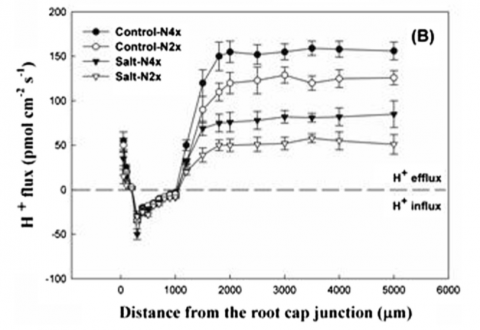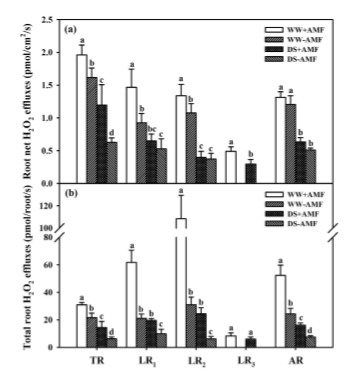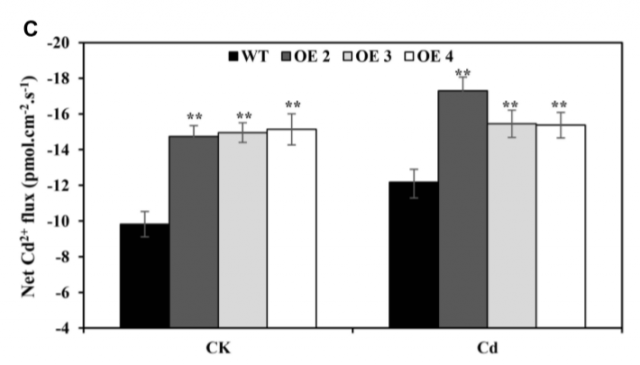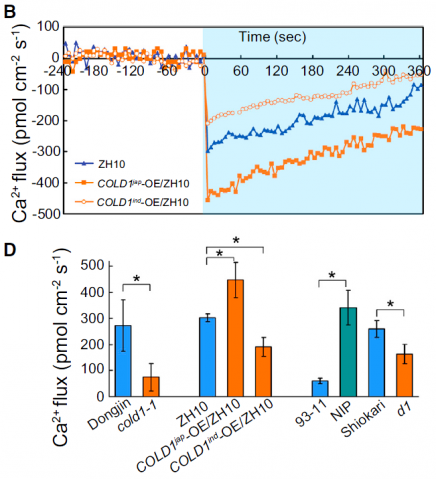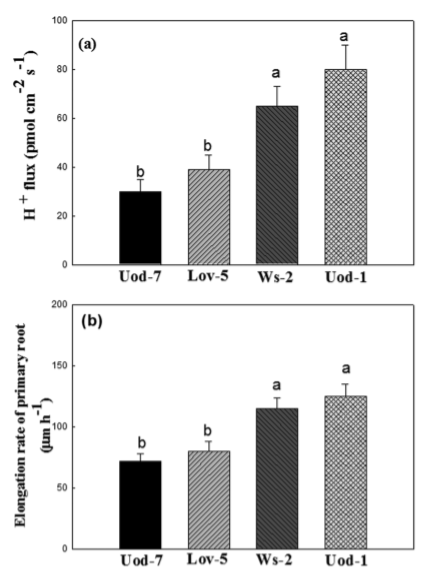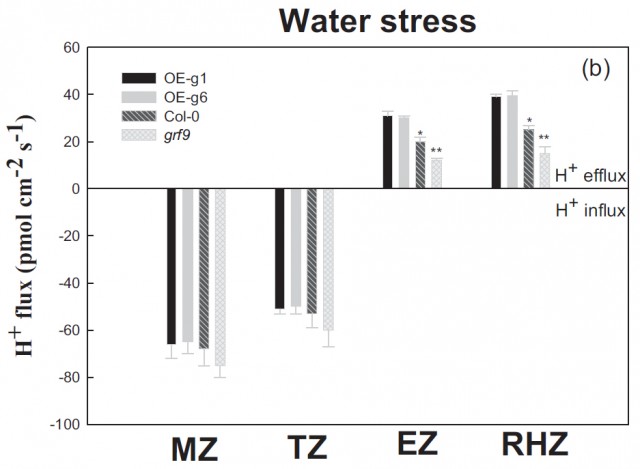What is the #1 most harmful factor affecting crop growth worldwide? Insects nibbling on leaves may spring to mind, but the real problem is not bugs, but actually abiotic stressors. Rather than living threats, abiotic stressors encompass all non-living negative factors, such as salt, drought, and heavy metals.
Abiotic stress research in plants also happens to be the top most-studied field by labs that use our NMT instruments! While our technology is applied in a vast and varied number of research fields, it has exploded in popularity over the last 10 years among plant stress scientists.
A few areas we will cover today include:
1. Salt stress
2. Drought stress
3. Heavy metal stress
4. Cold stress
5. Alkaline stress
6. Water stress
These are all real examples of popular fields studied with NMT instruments, and now we offer the new NMT Physiolyzer® to continue revolutionizing this field. Since its launch, scientists have made more strides in abiotic stress research with the NMT Physiolyzer®, and its popularity is still rising.
Which ions or molecules could you choose for your personalized NMT Physiolyzer® to study these stress applications? Read on to find out.
1. Salt stress
Rice is a staple crop for more than half the world's population, but unfortunately, it is rather susceptible to salt stress. Research has been done on improving salt tolerance in rice, but few have investigated the effects of genome duplication for this purpose.
In 2014, Professor Xu Weifeng of the Nanjing Institute of Soil Science, Chinese Academy of Sciences and the Chinese University of Hong Kong published a paper in the journal Rice, about his team's research on genome duplication for salt resistance in rice.
They observed and revealed an important mechanism for the enhancement of salt tolerance in diploid and tetraploid rice. They used NMT to measure the H+ fluxes in conditions of salt stress and a control in the different-genomed rice. They found an increased rate of H+ efflux in the salt-stressed tetraploid, and also found a stronger resistance to salt stress effects. They concluded that genome duplication may improve rice resistance to salt stress, perhaps by increasing the efflux of H+ and thereby reducing Na+ influx.
Reference: Tu Y, et al. Genome duplication improves rice root resistance to salt stress. Rice. 2014, 7:15.
Figure Note: H+ flux of Nipponbare-2x and -4x under salt stress.
2. Drought stress
Drought stress is a common abiotic barrier to crop growth, and it triggers oxidative stress at the same time. During drought stress, plants generate reactive oxygen species (ROS) such as H2O2, which can cause major damage.
In February 2017, the research team of Wu Qiang of Yangtze University published an article in Scientific Reports about their investigation into drought stress in an arbuscular mycorrhiza (AM), made up of trifoliate orange seedlings and the Funneliformis mosseae fungus. They used our technology, NMT, to measure H2O2 fluxes in the roots, helping them assess the oxidation.
The results showed that the drought strongly inhibited the mycorrhiza propagation in the main and lateral roots. They also found a positive correlation between root H2O2 efflux and root reproduction, indicating that the mycorrhiza reduced the oxidative damage of plants under drought stress by promoting the efflux of H2O2 in the main and lateral roots. This indicates that the mycorrhiza can be of use in preventing the effects of drought stress.
Reference: Huang Y, et al. Alleviation of drought stress by mycorrhizas is related to increased root H2O2 efflux in trifoliate orange, Scientific Reports, 2017, 7:42335.
3. Heavy metal stress
Cadmium accumulation in plants can also lead to oxidative stress. In order to clean up cadmium from soil, there are some plants called hyperaccumulators that can extract metals from the soil while resisting oxidative damage.
In June 2017, Zhuo Renying's research group of the Chinese Academy of Forestry's Subtropical Forestry Research Institute isolated the Cu/Zn SOD gene from the hyperaccumulating southeast Sedum, and induced this gene in Arabidopsis thaliana to express in cadmium stress. They wanted to see if this gene could help non-hyperaccumulating plants to resist the oxidative damage caused by Cd2+ intake.
They found that the overexpression of this gene increased the antioxidant defense ability of transgenic Arabidopsis thaliana compared to the wild type, and reduced the oxidative damage. NMT was used to measure the Cd2+ flux on the root surface under cadmium stress. They also found that over-expression of the gene increased the Cd2+ absorption capacity of the Arabidopsis root. It seems that the gene increased Cd2+ influx but also succeeded at helping the plant resist any associated oxidative damage.
Reference: Li Z, Han X, Song X, et al. Overexpressing the Sedum alfredii Cu/Zn Superoxide Dismutase Increased Resistance to Oxidative Stress in Transgenic Arabidopsis. Frontiers in Plant Science, 2017, 8(1010):1010.
Figure Note: Net Cd2+ fluxes in the roots of transgenic (OE2, OE3, and OE4) and WT plants.
4. Cold stress
Weather and temperatures are not always as predictable as we'd like, and a sudden cold snap can mean a huge loss of crops. Genetic research can help improve the cold tolerance of some important crops, and a staple like rice is a good place to start.
In March 2015, researchers from the Chinese Academy of Sciences Institute of Plants, Planting, and Health published an article in Cell about enhancing the cold tolerance of rice. These researchers found that the COLD1 gene is very important for the cold resistance of indica rice. Overexpressing this gene can help improve tolerance, while a mutant lacking the COLD1 gene is very sensitive.
In this study, they detailed a full new mechanism that includes the activation of Ca2+ channels. NMT was used to measure the Ca2+ fluxes which provided crucial evidence that these channels were activated under cold stress, and was important for outlining the whole mechanism of how COLD1 provides cold resistance.
Reference: Ma Y, et al. COLD1 Confers Chilling Tolerance in Rice. Cell., 2015,160(6):1209-21.
Video: http://youngerusa.com/index.php/about/nmt-blogs/nmt-helps-reveal-how-crops-cope-with-cold-stress
Figure Note: NMT measurements show extracellular Ca2+ influx during cold shock in live roots of various genetic backgrounds.
5. Alkaline stress
Alkalization of soil is a widespread environmental problem that limits agricultural production. Although some studies in recent years have shown that alkaline stress inhibits the growth and development of plants even worse than salt stress, the mechanism of how plants adapt to alkaline stress has not been widely studied.
In 2012, an article published by the Zhang Jianhua Laboratory of the Chinese University of Hong Kong investigated the role of the PIN2 gene in the regulation of proton secretion during alkaline stress.
They used NMT to measure H+ flux in Arabidopsis roots. They found that under alkaline stress, the transcriptional level of PIN2 was positively correlated with the rate of primary root elongation and proton secretion capacity. The results of this study confirm that PIN2 is an important factor in the adaptation to alkaline stress, as it seems to help resist the stress by maintaining the primary root elongation via H+ efflux regulation.
Reference: Xu WF, et al. PIN2 is required for the adaptation of Arabidopsis roots to alkaline stress by modulating proton secretion. Journal of Experimental Botany, 2012, 63(17): 6105-6114.
Figure Note: H+ flux (efflux) at 750 µm from the root cap junction and the rate of primary root elongation after 12 h of alkaline stress (pH 8.0).
6. Water Stress
Plants may need water to survive, but too much water can drown many crops. What if the sky decides to release torrential downpours and flood the fields? We can't control the weather, but maybe some changes in gene expression can toughen up the plants.
In 2015, Zhang Jianhua of the Chinese University of Hong Kong and Xu Weifeng of the Nanjing Soils Institute decided to investigate the role of the protein GRF9 in root growth during water stress. They used NMT to measure H+ fluxes in Arabidopsis roots of varying GRF9 expressions, and found that GRF9 promoted the efflux of H+ in the root hair and elongation zones of Arabidopsis root under water stress conditions.
Reference: He Y, et al. Involvement of 14-3-3 protein GRF9 in root growth and response under PEG-induced water stress. Journal of Experimental Botany. 2015, 66(8): 2271-2281.
Figure Note: H+ flux in different genotypes of Arabidopsis under water stress in the meristem, transition, elongation, and root hair zones.
Further Research
These are all real life studies of how NMT has helped scientists study abiotic stress, and there are many more as well (Check out our Publications). Today we looked at:
1. H+ flux in salt stress
2. H2O2 flux in drought stress
3. Cd2+ flux in heavy metal stress
4. Ca2+ flux in cold stress
5. H+ flux in alkaline stress
6. H+ flux in water stress
But it doesn't stop there: there are far more ions and molecules that could help further each research field. Now with our new NMT Physiolyzer®, you could take the research in this field even further! With the option to customize your system, you can choose the exact ions or molecules you need for your abiotic stress research! What are you waiting for? Contact us now for your personalized NMT Physiolyzer® quote, and stay tuned for more NMT Applications!
Experience the NMT Physiolyzer® Our most advanced NMT system yet: This highly advanced instrument is allowing scientists to discover physiological functions of live samples in innovative new ways. With customizable software, you can choose from 12 ions and molecules for your own personalized system.
The Theory of NMT Check out the principles of how NMT works.


